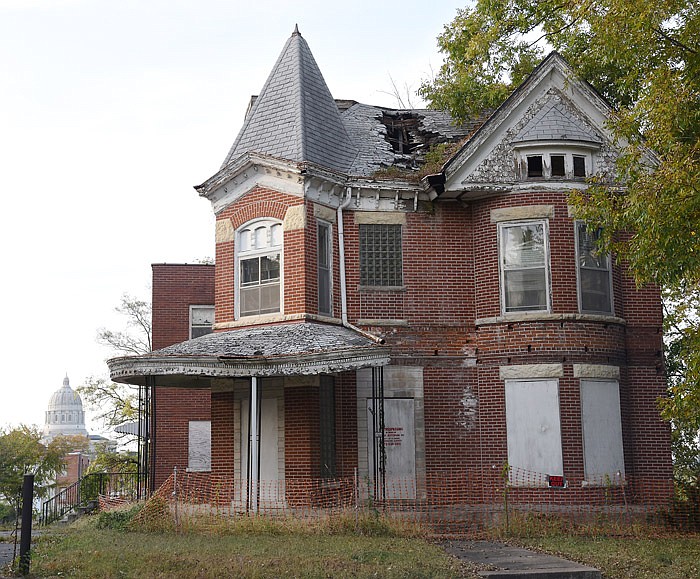It was Missouri's own President Harry S Truman, in his Housing Act of 1949, who introduced the concept of urban renewal to the American populace.
In a few days, anticipating final passage of a funding agreement with the Housing Authority at the Jan. 3 City Council meeting, Jefferson City will initiate a 21st century version of Truman's urban renewal.
Urban renewal was a relatively small piece of what was known as "The Fair Deal" under the president from Independence.
The domestic legislative package brought America federally financed slum clearance, the Federal Housing Administration and federally backed mortgage insurance, a federal commitment to build 800,000 public housing units and federal funding for rural housing. It is said Truman's landmark urban renewal actions moved 5 million Americans from "slums and firetraps" and provided housing for 3 million more who had previously been sharing housing with others. It is estimated the United States spent $13.5 billion on urban renewal between 1953-86.
In Jefferson City, the East Capitol Avenue Urban Renewal Plan will not specifically target housing for lower-income families.
As Mayor Carrie Tergin envisions it, the 38.1-acre redevelopment project in a prime neighborhood inside the boundaries of Adams, Marshall, State and Commercial Way, this urban renewal will result in a glossy, historically important expanse of early 20th century - and even some 19th century - landmark properties. It will be the East Capitol Avenue she knew as a youngster on Sunday drives with her family.
The area begs descriptors not generally favorable in 2017, however. Shabby, decrepit, downtrodden and, as formally and officially defined, it is a blighted neighborhood unwelcoming to many in Jefferson City.
The mayor, City Council, Housing Authority, Historic City of Jefferson and virtually every organization in the community have coalesced around the belief that urban renewal's time has come at long last.
So what is urban renewal? Here's one definition, authored by the Portland law firm Tashman Johnson: "The purpose of urban renewal is to improve specific areas of a city that are poorly developed or underdeveloped. These areas can have old deteriorated buildings and bad streets and utilities or the areas can lack street and utilities altogether."
In the world of urban renewal, "blight" is the key word.
Jefferson City retained St. Louis firm PCAV Planners to analyze the East Capitol neighborhood. PCAV established beyond any question that the area was blighted.
In its July report to the City Council, PCAV opened the understanding of the sad state of affairs in East Capitol by explaining Missouri law: "The State of Missouri provides various statutory tools that a community may utilize in order to facilitate private or public development or redevelopment in a declining area or to induce the development of an area that has been deficient in growth and development. One such tool is provided for in the Land Clearance for Redevelopment Authority Law."
In Jefferson City, that law provides for the creation of a Land Clearance for Redevelopment Authority (LCRA), "which is granted various powers of authority to carry out a redevelopment or urban renewal plan for landclearance and urban renewal projects," PCAV explains. The local LCRA operates as a companion of the Housing Authority.
Using the LCRA legislation, Jefferson City has, by council-passed ordinances, declared East Capitol a blighted area.
PCAV put the problem in plain English: "After consideration and examination of each individual parcel in the area, the area, on the whole, is a blighted area, as such term is defined in law. The area meets the requirements for a blighted area, exhibiting factors including, but not limited to: defective or inadequate street layout; unsanitary or unsafe conditions; deterioration of site improvements; improper subdivision or obsolete platting; and existence of conditions which endanger life or property by fire and other causes."
Four months after PCAV's study became part of the East Capitol urban renewal discussion, the Housing Authority produced, presented and effectively sold its position statement, which was an endorsement of the PCAV treatise.
In its summary, the Housing Authority sold the facts:
"During field investigation, many instances of deterioration to primary and secondary building components, as well as to utilities and paved surfaces, were observed to be affecting the vast majority of the structures in the area. 79 improved parcels have deteriorated site improvements. This represents 75 percent of the improved parcels. The fact that (72 percent) of the buildings are more than 80 years old has accelerated the level of deterioration in area buildings.
"Three-quarters of the property demonstrates varying levels of deterioration, many of which have been previously described. These include: rotting window and door frames; roofing that is worn or missing shingles; eaves, soffits and facias that are rotting, missing or falling; porches, steps and exterior stairways that are rotting, severely cracked or spalling, hand railing that is leaning, rotting or generally unstable; falling or missing gutters and downspouts; exterior walls exhibiting various signs of deterioration including siding, bricks and mortar showing signs of step-cracking and a need for tuck-pointing; sidewalks, driveways and other paved areas of the parcels that are cracking, spalling, heaving or sinking; and shrubbery that is overgrown, dead or dying."
The Housing Authority also reported that the physical blight was causing economic loss to the city: "All but 14 of the 116 properties in the area have either declined or have had no increase in value over the seven-year period from 2007 to 2015."
That represented a loss of nearly $778,000 in assessed value for just 35 of the "declining properties" in the seven-year span. "Many of the parcels are not worth more than the value of the land and in instances where the condition of the building would require demolition, the cost of demolition is really an offset to the value of the land," the Housing Authority report states.
With this evidence driving the expedited movement to initiate appraisals and acquisition of the East Capitol properties, the City Council is expected to give final reading to an ordinance Tuesday to a funding agreement with the Housing Authority.
The council is expected to approve the plan, a necessity before the Housing Authority begins executing its game plan. Which opens the question of what this urban renewal is going to cost. The short answer is the city doesn't know - not now, at least.
That funding proposal to be presented by city counselor Ryan Moehlman explains, "The fiscal impact of the agreement is extremely hard to ascertain because the ultimate fiscal impact on the city will depend on the costs of acquisition of properties and market conditions which will dictate the price at which any property is sold, which are unknown at this time."
Under the proposal, the city can evaluate each property before acquisition so it can determine whether it wants to participate with the Housing Authority, which will be the agency that is actually tasked with the urban renewal. That includes controlling the disposition of the targeted properties. If the sale of the property yields less than what the Housing Authority spent to acquire it, including costs and expenses for appraisers, attorney's fees and court costs, the city would be obligated to reimburse the Housing Authority for any unrecovered expenditures.
With its funding agreement with the city a lock, the Housing Authority has announced it will follow this timetable:
Jan. 17 - Solicit proposals for appraisals.
Jan. 24-Feb. 7 - Send letters to property owners opening negotiations.
March 21 - Issue purchase offers to current owners.
May 25-July 25 - Close on voluntary sales.
May 25 - If owners refuse offers, proceed with condemnation.
July 1 - Court sets condemnation hearings.
Aug. 1 - Housing Authority takes possession of first group of properties, unless condemnation is appealed, which could require nine months to two years.
On Jan. 10, one week after Tuesday's City Council meeting, the Housing Authority and City Council will host what they have labeled an "open public forum" to provide both parties to the decision-making process guidance on which parcels to pursue and in what order.
"This will be a listening session where the public has an opportunity to express their views on prioritizing the properties to be acquired as the urban renewal plan is implemented," the Housing Authority and City Council say.
Officials of both entities have said they want to hear residents' priorities regarding parcels in the worst shape to be appraised, acquired and either rehabilitated or removed and replaced with something new and better; or parcels in the best condition now to be first in line for some fashion of action. Once the first 10 parcels are confirmed, for instance, the unchecked momentum of urban renewal will be unleashed.
While the legalese is heavy reading, and the public meeting poses questions of political pressure, the two steps constitute the final hurdles in the decades-old pursuit of real facelifts to the dozens of pimpled, disheveled historic homes that Tergin longs to pass again soon looking like they did in her - and their - youth.


